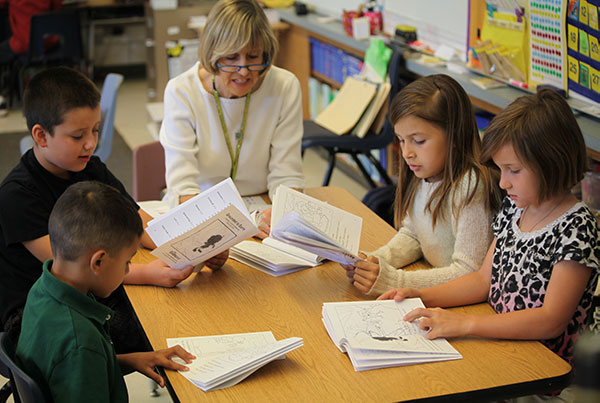For me as a classroom teacher, guiding my students in their reading was like being a coach: working from the sidelines, observing, and reminding students how best to play. A teacher can’t do the reading for her students, but she can provide reminders to correct errors as they happen, the way a coach corrects the players in the game.
As a teacher, I guided students as they read and used new skills. Guided reading means just that: guiding rather than instructing, and giving students the chance to practice. Guided reading also develops independence, encouraging students to read on their own without the assistance of a teacher or parent.
Guided Reading in Practice
Each teacher should decide what she wants her own guided reading to look like. My guided reading was an active, engaged reading time with students each reading their own leveled book. My groups tended to be heterogeneous with two early fluent readers, two emerging readers, and two early emergent readers.
The beginning readers would sit at my side, so I could closely coach them, model reading for them, and use decoding strategies on specific targeted words. The effective readers would pause on a word, use a decoding strategy themselves, and continue reading, while I observed them. The developing readers would pause, but needed my support to decode using a strategy before continuing to read.

My teaching spanned three decades, so technology evolved significantly over that time. As I began using Raz-Plus leveled books with my students, I discovered that I could still be a “coach” guiding them through the reading process – but now I had many more tools and resources available, enabling me to become an even better coach.
With Raz-Plus, I could use the reports to monitor my students’ progress and review their recordings. The Raz-Plus printable and digital quiz was also a vital part of the guided reading, or small group, process with my students, because I needed a comprehension check to be sure that they could not only read the book but also understood what they read. Using targeted, small group instruction, students in my classroom were able to move to a new level every month.
TIP: Assess student reading levels using Raz-Plus Benchmark Passages and digital Running Records. Students record themselves reading, which allows the teacher to go back later and review the passage – especially useful for developing and struggling readers. The teacher then assigns each student level or skill-appropriate practice, monitors progress using recordings and quiz results, and assigns a new running record when the student is ready to advance to the next level or has developed proficiency with the targeted skill.
Using Raz-Plus and Reading A-Z Guided Reading Lessons
Raz-Plus leveled books provide structured lesson plans that follow a before, during, and after reading format. This format supports best practices and helps the teacher deliver instruction tailored to students’ unique needs.
- Before Reading sets the stage for instruction by building the story’s background and by introducing the book, the comprehension strategy, relevant vocabulary, and the purpose for reading the selection.
- During Reading gives the student the opportunity to read the selection while the teacher models and guides the reading. The teacher takes the opportunity to do a Think Aloud and to check for understanding during the reading.
- After Reading encourages the students and teacher to reflect on the reading strategy and comprehension skills and to investigate the level of understanding. The lessons have an independent practice activity to extend and deepen comprehension. Many also feature an activity where students can offer an opinion based on what they learned.
Engaging Students with Activities After Guided Reading
Independent practice allows students the opportunity to apply what they have learned.

Using Raz-Plus digital books, students can:
- Read at their level, in class and at home
- Use interactive journaling and annotation tools to practice new skills and strategies
- Use the recording feature to record repeated readings to build fluency and comprehension
With the vast library of text types, students can apply learned skills and strategies across a range of genres.
Raz-Plus Guided Reading: A Success Story
I’ll close with a very personal story of success with Raz-Plus guided reading. As a first grade teacher and then an intervention teacher, I was able to watch many of my first grade students as they progressed over the years.
One of my struggling readers really wanted to learn to read, but he was just not ready. Two years later in my intervention class, he was the one who sat right next to me as we struggled together. At the end of that year, I was asked privately when I was going to retire. I said without even a moment’s hesitation, signaling this student: “When he can read.”
The following spring, he returned to my intervention class. We set to work again. This time he was ready. He sat next to me every day listening to recordings on his iPad and reading his Raz-Plus digital books.
One day, he began to record himself reading and to my amazement, he was reading on his own. I told him proudly when he was done, “Now I can retire! Because now you can read!”


